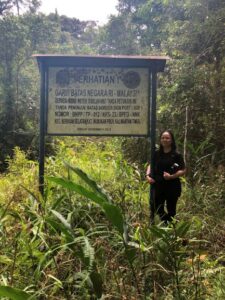観光によって促進される地域文化資源の再構築と変容/バンカ・ブリトゥン州の事例から
対象とする問題の概要 私は現在、インドネシアのバンカ・ブリトゥン州に着目し、観光産業が現地の地域文化資源の再構築と変容に果たす役割を研究している。同州は18世紀以降世界的な錫産地であったが、近年は枯渇してきており、錫に代わる新たな産業のニ…

Meeting the Director of the Institute of Borneo Studies (IBS) at Universiti Malaysia Sarawak (UNIMAS), Professor Dr. Poline Bala
The Sa’ban are one of the smaller indigenous peoples living on Borneo Island, Sarawak, Malaysia, and Kalimantan, Indonesia. Despite living in a different locality today, the Sa’ban originated from the Bahau and Ulu Krayan areas (then Dutch Borneo) now governed by the Indonesian state before the course of migration and history created the political Malaysia-Indonesia border, dividing the Sa’ban into Malaysian and Indonesian, respectively.
While differing in nationality, the Sa’ban in both countries remain close-knit even today. However, in Sarawak, the Sa’ban ethnic identity is ambiguous, where they are often associated with the Kelabit and Kenyah (Rousseau (1990), Mashman (2017) & Clayre, A. (2020)). Meanwhile, in Kalimantan, it is not clear what the status of their ethnic identity is except being associated with the Lundayeh Daye and Lenglilu in Kalimantan (Mashman, 2017) since the Sa’ban of Borneo is still an understudied area with not much in-depth literature available to date.
Hence, my research is qualitative, which aims to investigate the identity of the Sa’ban people that had been divided by the Malaysia-Indonesia border on Borneo Island. In Sarawak, Malaysia, the Sa’ban community lives principally in Long Banga village, while in East Kalimantan, Indonesia, the Sa’ban community lives principally in Long Layu village.
My research aims to investigate: i) the cultural characteristics of the Sa’ban communities in Sarawak and Kalimantan; ii) the state governance’s influence in forming the Sa’ban ethnic identity in respective nations (Malaysia and Indonesia); and finally, iii) what it means to be a Sa’ban as an individual.

Trekking across the Sarawak, Malaysia-Kalimantan, Indonesia border via Pa’Mada, Bario route (local route)
Through my fieldwork, I managed to gather and clarify valuable information relevant to my research objectives. Besides that, I am also able to establish contact and network with the locals, which will accommodate my future research in the field.
From my research fieldwork, I have observed several key findings. Despite belonging to different nationalities, Malaysia, or Indonesia, the Sa’ban in general (especially the Malaysian Sa’ban) acknowledge that they are of the same ethnic group and that their ancestral history began in Bahau and Ulu Krayan areas (now governed by the Indonesian state). In fact, the Malaysian Sa’ban can still trace their direct lineage to the Indonesian Sa’ban community, establishing a network of kinship between the two. Similarities between them are in their dominant religion (Christianity), language (the Sa’ban language), traditional clothes, and agricultural economy (specifically, rice farming).
On the other hand, there are also differences between the two, which include their ethnic status within the state as attributed to the respective state’s policy of ethnic classification. Besides that, while both Sa’bans share similarities in their agricultural economies when it comes to rice farming, the difference lies in the type of rice cultivated (hill paddy for Malaysian Sa’ban, wet paddy for Indonesian Sa’ban) and other agricultural activities. For example, the Indonesian Sa’ban also produces a popular product in the region, such as spring salt, while the Malaysian Sa’ban currently sees a bloom in coffee farming. Finally, there is also a difference in the state’s planning and development of the land of the Sa’ban community in respective countries, where I have learned about the implementation of “grouping of villages” by the Indonesian state and the struggle of Native Customary Rights (NCR)-related issues faced by the Malaysian Sa’ban.
The Sa’ban of Borneo is still an understudied subject; therefore, more extensive research into the environment, society, and culture of the Sa’ban community both in Malaysia and Indonesia is still needed. For my further research, I would like to explore the history and genealogy of the Sa’ban people and how they eventually came to be Malaysian and Indonesian, respectively.
Clayre, A. (2020). The Sa’ban of Borneo and Zomia. Journal of Borneo-Kalimantan, 6(2).
Mashman, V. (2017). Sa’ung seling sun-hats in the Sarawak Museum: Vehicles for Sa’ban, Lepo Keh and Badeng histories. Sarawak Museum Journal.
Rousseau, J. (1990). Central Borneo: Ethnic identity and social life in a stratified society. Oxford University Press.
Copyright © 附属次世代型アジア・アフリカ教育研究センター All Rights Reserved.